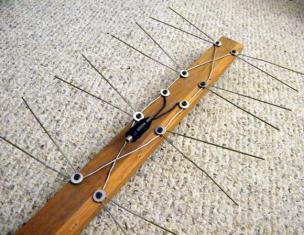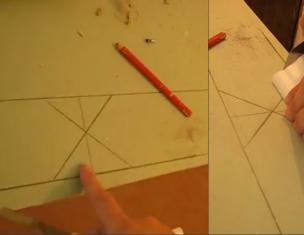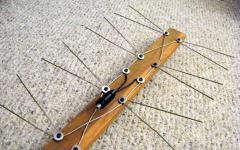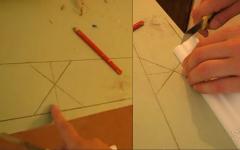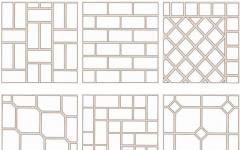List of calculations
For starters, let's find out what we have to consider.
- If the ceiling is planned, we will have to find out the full area of \u200b\u200bthe room in which the repair is to be.
Anticipating the sarcasm of the reader who has not forgotten the framework of geometry: the calculation algorithm is not so obvious as it may seem.
Often the premises have a form that is very different from rectangular.
- The square of the walls of the room will also have to figure out. Here the task is complicated not only by the complex form of the premises, but also the presence of openings - door and window.
- Then we have to recalculate the resulting result in square meters into the number of packages of the material. A simple division of the total area of \u200b\u200bthe walls on the square does not suit: to be at least to take into account trimming.

- Finally, the simplest stage is a procurement cost estimate for repair budget planning.
Back to school
Calculation of the Room area
For a rectangular room, it is sufficient to multiply its length and width. Thus, the quadrature of the room with a length of 5.2 m and a width of 3.8 m is equal to 5.2 x 3,8 \u003d 19.76 m2.
What to do with spaces more complex shapes?
- We divide them on the simplest geometric shapes - rectangles and triangles. Since the calculation is performed as part of the preparation for repair, you can put markup directly to the old one.
- We measure all sides of each of the figures.
- We calculate the surface square for the obtained measurements. How to calculate the area of \u200b\u200bthe rectangle - we have already remembered; For a rectangular triangle, it is equal to half the work of his cathets.
- We summarize the results obtained.

Let's say if we managed to break the floor on a rectangle with a size of 3x4 m, another rectangle with a size of 2x2.5 m and a rectangular triangle with ratios of length 1 and 1.5 m, the total surface of the floor (and,) of the room will be (3x4) + (2x2, 5) + (1x1.5 / 2) \u003d 12 + 5 + 0.75 \u003d 17.75 m2.
Calculation of the area of \u200b\u200bthe wall
To calculate the total surface of the solid walls, the same algorithm is used: the length and height of each wall are measured, the measurements are variable, after which the results are summed up. To get the result less outlook, it is necessary, obviously, first to calculate the quadrature of each opening, and then the amount of the results obtained to deduct from the total area of \u200b\u200bthe walls.
How to find out the square of the surface of the curvilinear wall? Surprise: It is equal to the product of the height on the length of the arc, which is easy to measure the usual tape measure.
Let's decide the next example from the school year of geometry.
Dano: a rectangular room in Stalin's 4x5 m with one door (0.8x2.05 m) and two windows (1.2x1.8 m).
Ceiling height - 3.2 m.
- The total area of \u200b\u200bthe walls will be equal to (4x3.2) x2 + (5x3.2) x2 \u003d 57.6 m2.
- The openings will occupy (0.8x2.05) + (1.2x1.8) x2 \u003d 1.64 + 4.32 \u003d 5.96 m2.
- Walls less outlook - 57.6-5.96 \u003d 51.64 m2.

Calculation of the number of wallpaper
The instruction on the rough calculation is extremely simple: the square of the surface surface is divided into the wallpaper area in the roll, after which the result is multiplied by 1.2 - 1.3 (reserve for trimming) and rounded up to an integer in a large side. The more complex shape has a surface, the greater the necessary supply for trimming.
Thus, when pasting the ceiling in a rectangular room of 20 squares, an approximate number of rolls with a size of 10x0.6 m will be 20 / (10x0.6) x1,2 \u003d 1.44 (2 packaging taking into account rounding).
It is clear that the accuracy of the result is below any criticism: the amount of residue in each roll depends on the very specific length of the strip from the wall to the wall or on the floor to the ceiling, we also use statistics instead of accurate counting. If the price of the square meter of wallpaper is high enough, it is better to look for a methodology that gives greater accuracy.
Curious: a typical online wallpaper calculator on the walls of the wall works precisely on this algorithm.
Scripts, calculating the amount of trimming along the length of the strip and roll - a rare, but pleasant exception.

How to make a more accurate count?
- The width of the surface that is covered with a single roll material is calculated based on the length of one band (the distance from the wall to the wall or on the floor to the ceiling) and the size of the material in one package. Let's say, with a ceiling height of 3.2 meters and a roll size of 0.6x10 meters one packaging will give us the opportunity to stick three bands (10 / 3.2 \u003d 3,125) with a total width of 3x0.6 \u003d 1.8 m.
- Operactions when counting is not taken into account. Why? Yes, because in most cases we have to make a cut down under the opening in the whole lane of wallpaper or in two adjacent bands; The corresponding part of the roll is in trimming.
- The total length of the walls or the ceiling is divided into one part of it, which will be covered with wallpaper from one roll. Thus, in a rectangular room 4x5 meters the perimeter of the walls will be 4x2 + 5x2 \u003d 18 meters; Since one packaging allows you to leave 1.8 meters of the wall, we will need 18 / 1.8 \u003d 10 packages.

Calculation of the cost of wallpaper
Finally, the simplest stage of calculations. He can do it with his own hands even an individual who walked most of school lessons.
The total cost of purchasing material is obtained by a simple multiplication of the amount of material packages for the cost of each of them. In order not to experience the patience of readers who remember the foundations of arithmetic, the author will refrain the example of calculations.
Conclusion
It is easy to note that it suffices to have a minimum of spatial imagination and remember the basics of primary school program. As usual, the video in this article will offer the reader additional thematic information. Successes!



